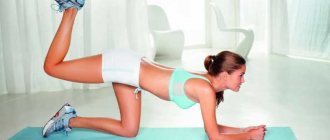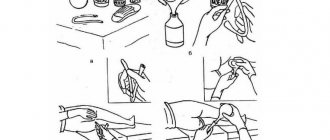The benefits of running on stairs
This method of losing weight is accessible to most people. Finding a free staircase is easy. If you don’t like to exercise surrounded by people, you can run in the entrance. You plan your class schedule yourself; you don’t need to spend money on them. Losing weight when running occurs faster. You can burn 500-900 calories in an hour. The main load falls on the leg muscles:
- calf;
- femoral;
- gluteal;
- iliopsoas.
Running on steps for weight loss increases calorie consumption per day, trains muscles and endurance. The amount of oxygen entering the cells increases, which activates the fat burning process. Weight loss will begin within half an hour after the start of the workout. The effect is the same as from any aerobic exercise. According to reviews, in a month of regular running on stairs a person loses 3-5 kg. The exact figure depends on:
- initial weight;
- nutrition;
- training frequency.
Nature of occupation
Don't try to make running up stairs your main workout. Let this become a useful addition to your regular runs in the park or stadium. You can include stair training in your strength training, if you have one.
If you are jogging up stairs, you need to calculate the load. Everyone has their own norm. It is better when you already have experience running on a horizontal track and know what heart rate your body can withstand.
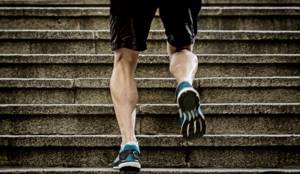
There are no standards for everyone. The common formula: subtract age from the number 220 is not an axiom. You need to check it for yourself. Therefore, the intensity of your training gradually, measuring your pulse.
Advice
Don't aim for the maximum number of hits. It will be more useful if, after actively climbing the stairs, you can catch your breath and do a few more runs.
The following technique will help you do this:
- At the top of the stairs, count your pulse.
- Slowly go down, trying to restore your breathing and heart.
- Below you again measure the number of strokes. They should become one and a half times lower than they were at the top. Until you achieve this, don’t start the next race.
After the steps, run along the city alley. At the end of classes, do exercises to stretch your muscles and ligaments .
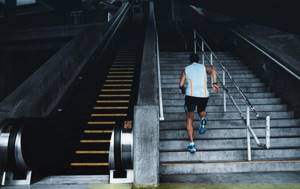
Preparation for training
When jogging to lose weight, you should wear comfortable clothes and special shoes. You need sneakers with springy soles. They will reduce the load on the joints and make training less traumatic. Before you start running, you need to determine the level of fitness of your body:
- Run 3-4 flights of not too long stairs at a moderate speed.
- Place 2 fingers on the wrist of your left hand closer to the right edge.
- Feel the pulse. Count it for 10 seconds.
- Multiply the resulting figure by 6. You can run on stairs if it is within 120-140 beats/min.
People whose heart rate after a short run is above 140 beats/min need to prepare themselves by simply walking up the stairs. It is carried out for several weeks until the body gets used to it. Before running, you should warm up. It lasts 7-10 minutes. It must include:
- going up and down stairs;
- bends;
- squats;
- jumping;
- swing your arms and legs.
Consider important factors
If you are already working out on the steps, then you have probably heard from your colleagues about the diets that runners use to lose weight. Listen to such “weight loss teachers” with caution. After all, during intense training, getting carried away with food restrictions is harmful - this can lead to a lack of microelements and glucose in the body, which will cause weakness and dizziness. Also, if there is a power load, the diet should have enough animal and vegetable protein.

Running on steps has physical hazards: be aware of the surface of the steps and wear running shoes with soles that provide good traction on level surfaces. Some types of materials from which steps are made can cause injuries in rainy weather or the winter season.
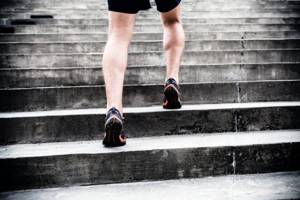
If you experience pain in your kneecaps or ligaments, cover the planned route on foot or complete the activity. But after this, be sure to walk at a slow pace, relaxing your muscles. After all, the reasons for unsuccessful training can be:
- Stagnant muscles.
- Unusual tension.
- Weak joints and bones.
nutrients to the affected cells so that they restore their normal state.
It is important
Regular exercise without excessive stress will make your legs and whole body strong. Thanks to this, unpleasant sensations will not interrupt your stair runs.
How to run up stairs correctly
Classes can be held outdoors and indoors. Running up the stairs in a building for weight loss is no worse than running on a machine. The only problem is the poor ventilation of most corridors of residential buildings. Choose a straight staircase with wide steps: the foot should be fully planted. It is advisable that the flight be long and you can run for 15 seconds without a break. Before you start jogging, remember the basic rules:
- Go up the stairs quickly, go down slowly. This way you will protect yourself from ankle injuries.
- Keep your heart rate within 60-80% of maximum. It is calculated using the formula “220 - age”.
- Watch your speed. Optimal - when breathing is frequent, but you are not suffocating.
- Exercise regularly every other day. Beginners can take 2 days to rest.
- Increase the duration of the lesson gradually. Start with 10 minutes, gradually increase to 30-60. Fat will begin to burn only after half an hour.
Experts have been arguing for a long time about what time of day is best to run for weight loss. It is better to burn fat in the morning, at 7-10 o'clock. Before this, you can’t eat anything except a white omelet. This is how old stocks will burn. Many people find it more convenient to run up the stairs in the evening due to work or school schedules. The exercise will save you from cravings to eat sweets at night and will help you burn extra calories received during the day. Evening and morning jogging have their disadvantages:
- People with vegetative-vascular dystonia should not run up stairs in the morning - there is a high risk of fainting.
- After an evening run, it will be difficult to fall asleep. This is true for people with a sensitive nervous system. Regular exercise can cause chronic insomnia. You will lose weight more slowly than with morning workouts.
Running technique
Proper breathing will help maintain good health and stimulate weight loss. Calm and deep breaths in through your nose and out through your mouth. Even if you increase your running pace, you should not change your breathing rhythm. If you feel like you're not getting enough oxygen, stop. Walk a few flights of stairs at a calm pace or walk around the site. The technique of running in a hallway, on a street staircase or on a simulator is the same:
- Take a step, place your foot completely on the step. The knee is bent to a right (!) angle.
- Shift your weight to your front foot and straighten your knee. Do not turn it off completely - it is dangerous.
- Step with your other foot and walk away with your supporting foot.
- While running up the stairs, keep your abs tense and your back straight. Tilt your body forward slightly. Hands are actively working.
- As you descend, tighten your glutes and reduce the stress on your knees. Reduce your speed, but take rhythmic steps.
How to increase the effectiveness of classes
Using the same running pattern to lose weight is not effective. The body gets used to the load and the process slows down. Experts advise having several training plans and alternating them with each other. When compiling them, you can use the following recommendations:
- Change the speed - 10 seconds the fastest, a minute moderate. Followed by another short interval at maximum. This alternation prevents the muscles from getting used to the load.
- Change the style of running up the stairs - with the heel to the buttocks, with the knees raised.
- Add exercises - do 2-3 per workout. To lose weight, it is useful to jump on two legs up the steps and perform lunges between climbs.
- Change the number of approaches, ascents and descents.
- Run up the stairs with dumbbells in your hands. Each weight is 1-2 kg. This will put more stress on your legs and strengthen your upper body.
- Choose different stairs – if possible. The longer the flight, the greater the load as you run longer without stopping.
- Dieting – climbing stairs for weight loss works by burning calories, but if you regularly abuse junk food, it is not effective.

Is the idea worth the candle?
Walking and running on steps is a folk sport brought about by civilization. This was led to by the development of transport, the equipping of buildings with elevators and the expansion of the share of mental professions.
Don't make a cult out of your activities. Previously they were not considered sports. This was the daily life of the townspeople:
- In large cities, people ran up the stairs of their multi-storey buildings every day when the relevant services could not ensure the serviceability of the elevators
- Numerous transfers when traveling to work forced residents to use courtyard paths, climbing flights of stairs that smooth out uneven terrain between houses.
- The office in which one had to work was often located in the common “anthill” of a rental building, which forced the employee to count with his feet the number of steps he managed to climb per day.
Now people are accustomed to comfort. Even food may be in short supply, but transport is more or less organized. After all, without it, no one will take your free work.
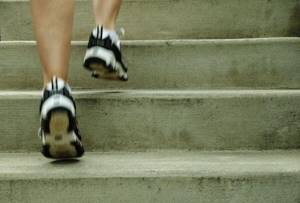
To avoid curling up next to your desk, you need to do physical exercise . And running up the stairs is most suitable. There is evidence:
- It's free.
- Everything is nearby. Every home, office, factory has steps. Their absence is rare. Then you will find them nearby.
- Training can be either a replacement for running or the gym, depending on the intensity.
If you decide that such activities make sense, then you can do them right today , because this does not require special equipment or physical training.

This is interesting
- [uaf_vkcount url='https://beginogi.ru/pomogayut-li-prisedaniya-dlya-bega-i-chto-luchshe/']
Do squats help for running and which is better?
- [uaf_vkcount url='https://beginogi.ru/aerobnaya-vyinoslivost-i-nagruzki-pri-takom-rezhime-trenirovok/']
Aerobic endurance and loads with this training regimen
- [uaf_vkcount url='https://beginogi.ru/pochemu-napravlenie-bega-na-stadione-protiv-chasovoy-strelki/']
Why is the direction of running in the stadium counterclockwise?
Training plan
At any level of physical fitness, you need to start your workout with a warm-up. Finish with leg stretching. Before jogging, you should spend a couple of minutes simply walking up and down the stairs. The most effective workout option for weight loss is 20 minutes of running on steps and 10 minutes on a flat surface. Afterwards, you can perform a set of standard cardio exercises:
- lunges;
- twisting;
- jumping;
- squats.
When drawing up a training plan, focus on how you feel. As your body gets used to it, increase the duration of the warm-up and add more complex exercises to the main block. Vary your running speeds. The break between approaches should be reduced to 10-15 seconds. On days off from running, you can give yourself other aerobic exercise: work on your abs, shoulders and arms.
For newbies
If you haven't run before, start running 3 times a week every other day or two. You need to spend 5-7 minutes warming up. It consists of bending, squats and lunges. 10 times continuously each exercise, do 1-2 approaches. Be sure to add rotations with your arms, head, and body. After the main training on the stairs:
- Climb at a moderate speed up 5 flights. Not running - brisk walking.
- Descending the same distance is a little slower.
- A minute to catch your breath.
- Repeat all steps for 7-10 minutes. After 2-3 weeks, perform them with a liter bottle of water in each hand.
For the trained
After a month of regular brisk walking up the stairs, you can practice running. You will determine your readiness to move to this stage by measuring your pulse and listening to your feelings. When walking stops causing shortness of breath and muscle tension, start jogging. They need to be combined with exercises. Start with 3-4 circles, gradually increase to 8-10. For effective weight loss, follow this schedule:
| Exercise | Initial execution time |
| Walking up and down | 2 minutes |
| Running up the stairs | 30 seconds each |
| Jumping up the steps | |
| Fast descent down | |
| Climbing up on half toes | 15 seconds |
| Climbing stairs via step | 30 seconds |
| Running up the stairs | 1 minute |
| Fast descent down | 30 seconds |
| Cross lunges on each step | 15 seconds each |
| Quick rise on hands and feet |
For advanced
A trained person can practice running up stairs 4 times a week. Between these classes, classic cardio will help you lose weight: jumping, squats, interval training. Warm-up lasts 10 minutes, then you need to walk 4 flights up and down. Afterwards it is recommended to alternate the following exercises:
- Running up the stairs.
- Jumping up stairs from a squat.
- Skater: Steps across the step with the right foot to the left and the left to the right.
- Push ups.
Spend 30-60 seconds on each of them. The advanced training lasts more than half an hour. For this reason, you need to spend 3-4 times more time on jogging than on exercise. It is important to control the technique and breathing. For one lesson, you can take only 2 exercises from the list and dilute them with a long run. You can do interval running:
- 30-60 seconds at maximum speed;
- 1-2 minutes of jogging;
- 1-3 minutes again at maximum speed;
- 2 minutes rest.

Running up the stairs in the hallway for weight loss
The simplicity of this type of training is accessibility, health benefits and effective weight loss. Visiting the hall requires travel time and money. You need to adjust your life to the work schedule of the gym and trainer. Many people are embarrassed to go to the gym, thinking that they will become a reason for ridicule. Running up the stairs makes everything easier. There is no need to run somewhere or adjust to someone else’s schedule. All you need to do is put on your sports uniform and go out onto the landing.
The process of such training has a number of advantages over cardio exercises in the gym:
- No one puts psychological pressure or pushes.
- A competent trainer is very difficult to find. Despite the large amount of advertising, there are very few highly qualified specialists and their services are very expensive.
- You can create your own training schedule. Individually plan the training process itself, its volume and intensity.
The results of an individually selected schedule will bring health benefits, weight loss to the body and relaxation of the nervous system.
What are the benefits of running up stairs?
This type of exercise can be said simply: running up the stairs in the entrance is beneficial for the whole body.
Of course, this type of exercise is much more difficult than jogging or regular walking. But this is its advantage. During the training process, a powerful load occurs not only on the lower, but also on the upper body.
The cardiovascular system has a positive effect, it works much more actively. This helps increase blood circulation . Blood saturates the muscles, as a result of which they receive an impulse for growth. Your figure will be the envy of others. In the process of regular training, joints and ligaments will become stronger, and they are the ones responsible for all the motor skills of our movements.
In addition to the above, walking on stairs has a therapeutic effect . Noticeable weight loss, strengthening of the cardiovascular system and almost all muscles, joints and ligaments not only have a positive effect on appearance and well-being, but also contributes to the prevention of many diseases. The risk of high or low blood pressure, intractable scoliosis, age-related varicose veins, cardiovascular disease, severe obesity, and cancer is reduced.
The most important thing is that the body is less susceptible to age-related changes.
What muscle groups work?
Most people are sure that complex muscle development requires a wide range of exercises and a huge range of sports equipment. However, this is not quite true. Running up stairs will involve most muscle groups, the largest of which in the human body are the legs.
Mistakes when running up stairs
A person who strives to lose weight ignores how he feels during exercise. This is one of the main mistakes. If during a run you experience shortness of breath, dizziness, pain in the side, or viscous saliva, this is a signal to slow down the pace. Unpleasant sensations in the muscles should also alert you. A few more common beginner mistakes:
- Talking while jogging means concentrating on breathing.
- Start with maximum speed and increase it gradually.
- Cling to the railing and lean on it - you need to keep your body level.
- Lifting your heels off the steps transfers the weight to your entire foot at once.
- Running in regular shoes will lead to injury.
Training Tips
- Never start running without first warming up. You must understand and feel that the muscles are completely unprepared for sudden changes. Therefore, we need to give them a sign that we will work now.
- Walk up the steps. As much as you can. Then, at an easy pace, run several floors higher, and go back down again on foot. This can be called the second part of the warm-up. In general, warming up is necessary in order to avoid pain, and in the worst case, injury.
- To make the load on the muscles much more intense, you need to overcome more and more steps, because at this moment you begin to burn fat deposits.
- Breath. Inhale and exhale, remember? You should always follow the principle of proper breathing, this is the key to your success.
- Regularity. To notice the positive effect of exercise, you need to train at least once every two days. I don't think it will be necessary more often.
- Gradually increase your training time. But you shouldn’t strain yourself too much either. Then you won’t want to not only run, but you’ll also have nightmares about the staircase landing.
- Add variety to your running. Read reviews from experienced runners, they all assure that monotonous activities will soon get boring. But you don’t want that, do you?
- Choose only light and natural clothes that will not restrict your movements. Shoes should be as comfortable as possible, with high-quality soles, because the main load goes on the joints.
I hope this article will serve you well on your path to health. And to always be aware of useful information for yourself and your family, I recommend subscribing to the blog. I promise a lot more useful information for parents and kids, and more.
Contraindications
Running on stairs can be harmful. It is hazardous to health when carried out in a poorly ventilated entrance. For a person with poor physical fitness, this activity can greatly worsen their well-being. It is not recommended to give such a load immediately after an illness or with headaches. Before starting training, you should visit a doctor. Contraindications to running on stairs are:
- diseases of the cardiovascular system;
- persistent hypertension;
- obesity (body mass index above 30 units);
- varicose veins and other problems with blood vessels in the legs;
- scoliosis;
- injuries of the lower extremities (especially knees, ankles, hips);
- diseases of the leg joints.
The effect of running up stairs on the body
If you climb 200 stairs up 2 times a day 5 times a week for at least 8 weeks in a row, your VO2 max (one of the main indicators of physical fitness) will increase by as much as 17 percent . This means that your body will absorb 17% more oxygen per minute than before you started running up the stairs. This will allow you to raise the bar on your aerobic training capabilities: increasing speed, endurance and calorie burning potential. So if you want to make progress in sprints or marathons, running stairs will come in handy.
If you climb 200 stairs up 2 times a day 5 times a week for at least 8 weeks in a row, your VO2 max (one of the main indicators of fitness) will increase by as much as 17 percent.




